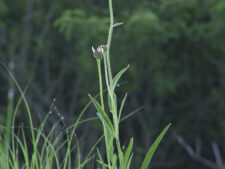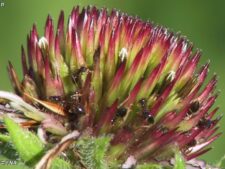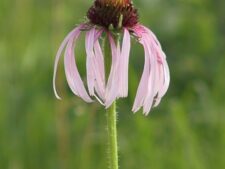
This native 1-3 foot tall perennial has stout, unbranched stems covered with coarse, stiff hairs. The leaves are long, narrow and mostly basal with smaller and scarce upper stem leaves (A,B). At the top of the stem is a single, showy flower head with drooping pale pink to pale purple, petal-like ray florets 1 1/2 to 3 inches long surrounding a dome-shaped disk with dark purple florets containing white pollen and reddish-brown, sharp-tipped bracts (C,D). The bracts, which turn dark brown after flowering, often remain in place through the winter.
Grows in moist to dry upland prairie sites, flowering in June and July. It is just west of its usual range, originating from seed used in restorations. It is uncommon in Neale Woods restorations where it has been seen in Knull and Jonas Prairies.
This coneflower has longer drooping ray florets and white pollen (B), features which separate it from Echinacea angustifolia, the native species found in our local prairies and Iowa’s Loess Hills. The narrow ray florets and smooth leaf margins separate it from Purple Coneflower (E. purpurea) which has broader lance-shaped leaves with sharply toothed margins.
Echinacea comes from the Greek meaning “hedgehog,” referring to the spiny bracts on its dome-like center. It is also known as Black Samson and Red Sunflower.
The content of NatureSearch is provided by dedicated volunteer Naturalists of Fontenelle Forest who strive to provide the most accurate information available. Contributors of the images retain their copyrights. The point of contact for this page is: Neal Ratzlaff.

 Identification
Identification

